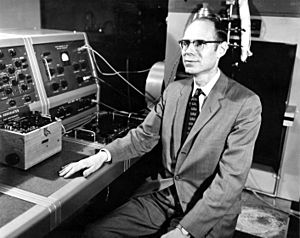John R. Pierce facts for kids
John Robinson Pierce (March 27, 1910 – April 2, 2002) was a brilliant American engineer and author. He made huge contributions in many areas. These included radio communication, microwave technology, and computer music. He also wrote science fiction books. He used pen names like J. J. Coupling. Pierce was born in Des Moines, Iowa. He earned his PhD from Caltech. He passed away in Sunnyvale, California.
Contents
Working at Bell Labs
John Pierce spent a lot of his career at Bell Labs. He wrote about electronics and how information travels. He helped create something called pulse-code modulation (PCM). This was with his colleagues Barney Oliver and Claude Shannon. PCM is a way to turn analog signals into digital ones. This is how digital phone calls and music work today.
Inventing the Transistor
Pierce also led the team at Bell Labs that built the first transistor. A transistor is a tiny electronic switch. It is a key part of almost all modern electronics. One of his team members, Walter Houser Brattain, asked him to name the new device. Pierce thought about what the device did. He came up with the name "transistor." He wanted it to sound like other electronic parts.
The way I provided the name, was to think of what the device did. And at that time, it was supposed to be the dual of the vacuum tube. The vacuum tube had transconductance, so the transistor would have 'transresistance.' And the name should fit in with the names of other devices, such as varistor and thermistor. And ... I suggested the name 'transistor.'
—John R. Pierce, interviewed for PBS show "Transistorized!"
Discovering the Traveling-Wave Tube
Early in his time at Bell Labs, Pierce worked on vacuum tubes. During World War II, he learned about Rudolf Kompfner's work. Kompfner had invented the traveling wave tube. This device helps make signals stronger. Pierce figured out the math for it. He even wrote a book about it. He later hired Kompfner to work at Bell Labs. Pierce famously said, "Rudy Kompfner invented the traveling-wave tube, but I discovered it."
Famous Sayings
John Pierce was known for his clever sayings. One popular quote is "Nature abhors a vacuum tube." This means that nature prefers the smaller, more efficient transistors. Another one is "Funding artificial intelligence is real stupidity." He also said, "After growing wildly for years, the field of computing appears to be reaching its infancy." These quotes show his sharp mind.
Pioneering Satellite Communication
Pierce played a very important role in satellite technology. He was a leader in developing Telstar 1. This was the first commercial communications satellite. It helped send TV signals and phone calls across the Atlantic Ocean.
Some people say Arthur C. Clarke first thought of using satellites in space. But Pierce also came up with the idea on his own. He might have been the first to talk about unmanned communication satellites. Clarke himself called Pierce "one of the two fathers of the communications satellite."
Life After Bell Labs
After leaving Bell Labs, Pierce joined Caltech in 1971. He became a professor of electrical engineering. He also worked as the Chief Engineer at the Jet Propulsion Laboratory.
In 1980, he retired from Caltech. He then moved to Stanford University's CCRMA. Here, he focused on computer music. He was a Visiting Professor of Music. He worked with other famous names like John Chowning and Max Mathews. At Stanford, he helped discover a new musical scale. He later named it the Bohlen–Pierce scale.
Books for Everyone
Many of Pierce's technical books were written for a wide audience. He wanted to explain complex topics simply. Some of his books include Electrons, Waves, and Messages and An Introduction to Information Theory. He also wrote Waves and Ear and Man's World of Sound. These books helped many people understand new technologies.
Awards and Honors
John Pierce received many important awards for his work.
- In 1960, he won the Stuart Ballantine Medal.
- In 1962, he received the Golden Plate Award.
- In 1963, he was given the IEEE Edison Medal. This was for his work in satellite communications. It also recognized his contributions to electron optics and traveling-wave tubes.
- In 1975, he received the IEEE Medal of Honor. This was for his ideas and work on satellite communication experiments.
- In 1985, he was one of the first people to receive the Japan Prize. This was for his amazing achievements in electronics and communication.
Personal Life
Besides his technical work, John Pierce loved to write science fiction. He used the pen name J.J. Coupling. This name comes from a physics term about how particles interact. He also had an early interest in gliding. He helped start one of the first glider clubs in the United States. His friend Richard Hamming said that talking to John Pierce was always very stimulating.
Pierce lived in several places during his life. These included Berkeley Heights, New Jersey, Pasadena, California, and Palo Alto, California.
In his later years, he and his wife Brenda were known for their dinner parties. They would invite many different guests. They would have lively discussions on topics like space, politics, and music. One of these parties was even mentioned in a book by his former student, Daniel Levitin.
John Pierce's important papers are kept at the Huntington Library in California. He was survived by his wife Brenda, his son John Jeremy Pierce, and his daughter Elizabeth Anne Pierce.


